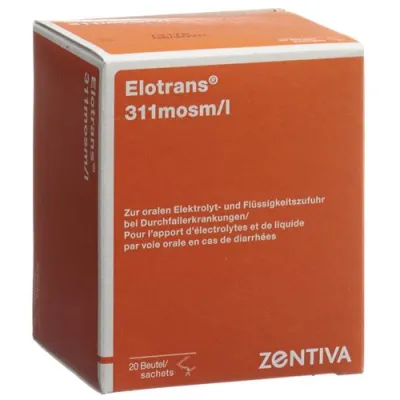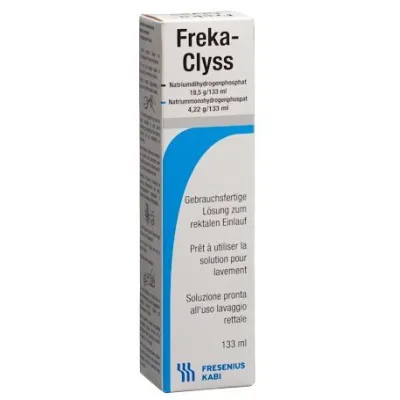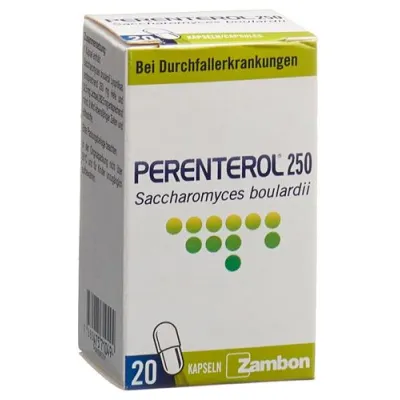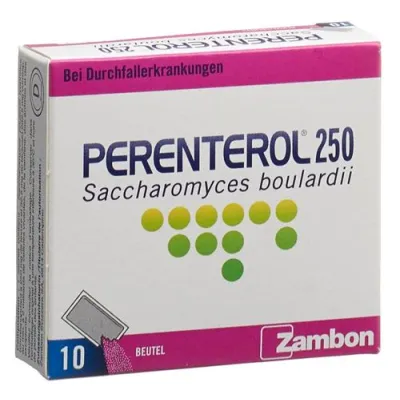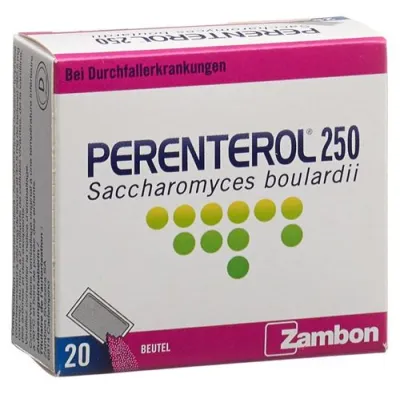Intestinal preparation
(1 Pages)
Elotrans powder 20 bags 6.03 g
Diarrheal diseases are often accompanied by a massive loss of water and mineral salts. Elotrans is a mixture of mineral salts which, from infancy, balances out salt and water loss in diarrheal diseases. Swissmedic-approved patient informationElotrans®Helvepharm AGAMZVWhat is Elotrans and when is it used?Diarrheal diseases are often accompanied by a massive loss of water and mineral salts. Elotrans is a mixture of mineral salts which, from infancy, balances out salt and water loss in diarrheal diseases. What should be considered?In addition to treatment with Elotrans, care must be taken to ensure a sufficient supply of water and/or low-salt solutions. A bag of 6.03 g contains 1⁄3 bread unit (BE), corresponding to 0.4 BW (bread value). When not to use Elotrans?In the event of renal dysfunction, metabolic alkalosis, sugar absorption disorders, unconsciousness, shock, persistent vomiting and if you are hypersensitive to any of the ingredients in Elotrans (react allergic. When is caution required when taking Elotrans?For use in children under 3 years of age with diarrhea, a doctor must be consulted. Patients with heart disease and high blood pressure should only take Elotrans after consulting their doctor. Due to the high sugar content (glucose), diabetics should only use Elotrans after consulting their doctor. If the diarrhea is accompanied by fever and if blood is found in the stool, a doctor should be consulted. Elotrans should also only be used in the following cases after consulting a doctor: If you have recurrent or persistent diarrheaIf you have liver or kidney diseaseIf you are on a low-potassium or low-sodium diet li>If your blood has low levels of potassium or sodiumElotrans should only be prepared with the specified amount of water. If more water than recommended is used, the salts will not be at an optimal concentration and if less water than recommended is used, this can lead to an increase in the imbalance of mineral salts in the blood. If the diarrhea lasts longer than 24 to 36 hours, you should see a doctor. If the diarrhea is associated with nausea or vomiting, begin by taking small but frequent sips. Inform your doctor, pharmacist or druggist if you suffer from other illnesses, have allergies or are taking other medicines (even those you bought yourself!) or using them externally! Can Elotrans be taken during pregnancy or breastfeeding?Based on previous experience, there is no known risk for the child when used as directed. Elotrans can be taken during pregnancy or while breastfeeding. However, medical supervision is recommended. How do you use Elotrans?Oral use after dissolving in drinking water or in boiled, cooled water or unsweetened tea. Elotrans should not be administered with fruit juice, milk or other liquids containing mineral salts. The content of one sachet is dissolved in 200 ml of liquid. Unless otherwise prescribed, children under one year take a maximum of 600 to 1000 ml (3-5 sachets), children up to 4 years of age a maximum of 1000 to 2000 ml Elotrans solution (5-10 sachets) spread over the day. In older children and adults, the Elotrans intake can be increased accordingly up to 20 sachets (4 l Elotrans solution). Up to 1 year: maximum 600-1000 ml per day. Up to 4 years: maximum 1000-2000 ml per day. From 4 years: up to 4000 ml depending on fluid loss per day. Elotrans treatment for infants usually lasts 6 to 12 hours, up to a maximum of 24 hours. Small children, school children and adults take Elotrans as instructed by the doctor until the diarrhea has subsided. If you have taken too much Elotrans, contact your doctor. Follow the dosage given in this leaflet or as prescribed by your doctor. If you think the medicine is too weak or too strong, talk to your doctor, pharmacist or druggist. What side effects can Elotrans have?The following side effects can occur when taking Elotrans: In individual cases, there may be a change in the amount of sodium chloride in the body. It is therefore important to ensure an adequate supply of water and low-salt solutions. If you notice side effects that are not described here, you should inform your doctor, pharmacist or druggist. What else needs to be considered?When traveling to warm or tropical countries, care must be taken to ensure that medicines are always carefully protected from heat and moisture. Elotrans bags should be stored at room temperature (15-25°C) and out of the reach of children. The medicinal product may only be used up to the date marked «EXP» on the container. Your doctor, pharmacist or druggist can provide you with further information. These people have the detailed information for specialists. What does Elotrans contain?1 sachet of Elotrans contains: glucose, anhydrous 4.0 g, sodium chloride 0.7 g, sodium citrate × 2 H2O 0.59 g, potassium chloride 0.30 g. Excipients: saccharin, aroma (contains bergamot oil, among other things), coloring agent: caramel (E150). Total osmolarity of the ready-to-use solution: 311 mosm/l. Electrolyte content of the ready-to-use solutionNa+ 90 mmol/l = 90 mval/l. K+ 20 mmol/l = 20 meq/l. Cl– 80 mmol/l = 80 meq/l. Citrate3– 10 mmol/l = 30 meq/l. Approval number44644 (Swissmedic). Where can you get Elotrans? What packs are available?In pharmacies and drugstores without a doctor's prescription. Packs of 20 sachets. Authorization holderHelvepharm AG, Frauenfeld. This package leaflet was last checked by the medicines authority (Swissmedic) in June 2018. ..
24.78 USD
Freka clyss enema 20 bottles 133 ml
Freka-Clyss is an enema liquid for emptying the intestines. Freka-Clyss does not affect the upper parts of the intestine, so it is particularly suitable in cases where oral laxatives are not appropriate or can lead to irritation, e.g. in preparation for intestinal examinations. Freka-Clyss can also be used in patients who should avoid straining to defecate. Swissmedic-approved patient informationFreka-Clyss®Fresenius Kabi (Schweiz) AGWhat is Freka-Clyss and when is it used?Freka-Clyss is an enema liquid for emptying the intestines. Freka-Clyss does not affect the upper parts of the intestine, so it is particularly suitable in cases where oral laxatives are not appropriate or can lead to irritation, e.g. in preparation for intestinal examinations. Freka-Clyss can also be used in patients who should avoid straining to defecate. What should be considered?As with all laxatives, abuse of Freka-Clyss can lead to addiction. When should Freka-Clyss not be used?Freka-Clyss should only be used if necessary. Freka-Clyss should not be administered in the case of nausea, vomiting, stomach ulcers, colon abnormalities and acute renal failure. If there is a tear in the lining of the rectum (fissure in the rectum or anal canal), Freka-Clyss must not be administered because of the risk of perforation. Freka-Clyss must not be administered to infants, toddlers and children under the age of 12 because of the risk of serious adverse effects that may be fatal (see also the note under “When should caution be exercised when using Freka-Clyss?, Children” ). When is caution required when using Freka-Clyss?If Freka-Clyss is used repeatedly, the intestinal mucosa absorbs part of the sodium contained in the solution . This must be taken into account in patients with heart disease, kidney disease and hypertension. Incorrect use can damage the intestinal mucosa. The phosphate solution can then cause inflammation and tissue destruction. Intestinal perforation can also occur. A doctor should be contacted immediately if there is a change in general well-being, pain or bleeding from the anus after administration of Freka-Clyss. ChildrenFreka-Clyss must not be used in infants, small children and children under 12 years of age. Use in children can lead to serious complications, including fatal outcomes, in particular electrolyte disorders, especially increased serum phosphate (hyperphosphatemia) and reduced serum calcium (hypocalcaemia) and their clinical consequences such as tetany and cardiac arrhythmia. The treatment of older children and adolescents with Freka-Clyss should therefore be carried out with the necessary caution. Inform your doctor, pharmacist or druggist if you suffer from other illnesses, have allergies or use other medicines (including those you have bought yourself!)! Freka-Clyss contains methyl parahydroxybenzoate (E 218), which can cause allergic reactions, including delayed reactions. Freka-Clyss should not be used in patients with a methylparaben allergy. Freka-Clyss contains 133 mg sodium benzoate (E 211) per bottle. Can Freka-Clyss be used during pregnancy or while breastfeeding?Freka-Clyss should not be used at the beginning of pregnancy, or if there is a risk of miscarriage or premature birth . Systemic scientific investigations were not carried out. To be on the safe side, you should avoid taking medicines during pregnancy and breastfeeding or ask your doctor, pharmacist or druggist for advice. During breast-feeding, Freka-Clyss should only be used in urgent cases. How do you use Freka-Clyss?Adults and adolescents aged 12 and over need 1 bottle. In stubborn cases and for special clinical use: 2-3 bottles in succession. In general, applying Freka-Clyss half an hour beforehand is sufficient to prepare for examinations. Freka-Clyss should be used at room temperature (15-25°C)! Stick to the dosage given in the package insert or prescribed by your doctor. If you think the medicine is too weak or too strong, talk to your doctor, pharmacist or druggist. Freka-Clyss should be used as follows: see instructions for use. What side effects can Freka-Clyss have?The following side effects can occur: No side effects have been observed for Freka-Clyss when used correctly. It can still cause discomfort (irritation, cramps). Freka-Clyss can lead to increased phosphate levels (hyperphosphataemia) or reduced calcium levels in the blood (hypocalcaemia), especially in the case of incorrect use and non-observance of the contraindications. If you notice any side effects that are not described here, you should inform your doctor, pharmacist or druggist. What else needs to be considered?Freka-Clyss may only be used up to the point marked «Exp.» on the container. designated date are used. Your doctor, pharmacist or druggist can provide you with further information. These people have the detailed information for specialists. Store at room temperature (15-25°C). Keep out of the reach of children. What is included in Freka-Clyss?Freka-Clyss includes: Active ingredientsSodium dihydrogen phosphate anhydrous 139.1 mg/ml, sodium monohydrogen phosphate 31.8 mg/ml ExcipientsSodium benzoate (E211), methyl parahydroxybenzoate (E218), sodium hydroxide (for pH adjustment), purified water Approval number36308 (Swissmedic). Where can you get Freka-Clyss? What packs are available? Freka-Clyss is available in pharmacies and drugstores without a doctor's prescription. Packs of 1 x 133 ml and multipacks of 20 x 133 ml are available. Authorization holderFresenius Kabi (Switzerland) AG, 6010 Kriens. This leaflet was last checked by the Medicines Agency (Swissmedic) in June 2021. ..
121.92 USD
Perenterol kaps 250 mg 20 pcs
Perenterol 250 is an antidiarrheal and contains a yeast fungus (Saccharomyces boulardii) as an active substance. It is used to treat diarrheal diseases such as traveler's diarrhea and, if prescribed by a doctor, for the prevention and treatment of antibiotic-related diarrhea or diarrhea caused by tube feeding; in conjunction with other measures, it allows the restoration of the intestinal flora and the alleviation of diarrhea. Perenterol 250 regulates and normalizes intestinal activity. The Saccharomyces boulardii yeast is resistant to antibiotics and acts in a living form inside the intestine. It is not absorbed by the body. In various studies, an inhibiting effect on the development of various harmful bacteria and Candida albicans could be determined. Swissmedic-approved patient informationPerenterol 250, sachets and capsulesZambon Switzerland LtdWhat is Perenterol 250 and when is it used?Perenterol 250 is a Antidiarrheal and contains a yeast fungus (Saccharomyces boulardii) as an active ingredient. It is used to treat diarrheal diseases such as traveler's diarrhea and, if prescribed by a doctor, for the prevention and treatment of antibiotic-related diarrhea or diarrhea caused by tube feeding; in conjunction with other measures, it allows the restoration of the intestinal flora and the alleviation of diarrhea. Perenterol 250 regulates and normalizes intestinal activity. The Saccharomyces boulardii yeast is resistant to antibiotics and acts in a living form inside the intestine. It is not absorbed by the body. In various studies, an inhibiting effect on the development of various harmful bacteria and Candida albicans could be determined. What should be considered?In the case of diarrhea, the patient (especially children and older people) should drink enough fluids. If the illness lasts longer than 2-3 days, the doctor should be consulted. In infants, diarrhea can quickly become dangerous after just one day due to the loss of fluid and salt. You should therefore consult your doctor in good time. When should Perenterol 250 not be used?In the event of hypersensitivity to the preparation. Yeast allergy, especially to Saccharomyces boulardii. Perenterol 250 must not be used in patients with severe immune deficiency (e.g. HIV infections, organ transplants, leukemia, malignant advanced tumors, radiation, chemotherapy, long-term high-dose cortisone treatment). Patients with a central venous catheter (e.g. Port-A-cath) must not use Perenterol 250 because of the risk of infection with Saccharomyces boulardii. When is caution required when taking Perenterol 250?Since Perenterol 250 consists of living cells, the preparation must not be heated with a too hot (over 50 °C) , ice-cold or alcoholic liquid or food. Furthermore, the yeasts contained in Perenterol 250 are sensitive to antifungal drugs (antimycotics). If your doctor has prescribed such medicines for you, you must refrain from taking Perenterol 250 because its active substance will then be destroyed. Tell your doctor, pharmacist or druggist if you suffer from other diseases,have allergies ortake other medicines (including those you bought yourself!)! Can Perenterol 250 be taken during pregnancy or while breastfeeding?There are no objections to using Perenterol 250 during pregnancy or while breastfeeding. How do you use Perenterol 250?The preparation is taken orally. Initial dosage: take 2 sachets or 2 capsules (1 in the morning and 1 in the evening) on day 1. Further dosing: on the following days: 1 sachet or 1 capsule daily until no more symptoms of the disease appear. Upon medical advice, the initial dosage (2 sachets or 2 capsules daily) can be continued or increased over several days if necessary. In case of vomiting within 1 hour after administration of the drug, the intake must be repeated. Perenterol 250 can be administered to infants, children and adults in the same dosage. Applicationsachet: mix the contents of the sachet with liquid or mushy food, then swallow. For infants: sprinkle the contents of the sachet over the pap or add to the bottle. Make sure that the food is not too hot (not over 50 °C). Capsules: swallow the capsule with some liquid. Perenterol 250 can be taken at any time of the day. If you want to achieve a rapid onset of action, you can take the preparation before meals. You can also take Perenterol 250 with an antibiotic at any time, but not with an antifungal. Follow the dosage given in this leaflet or as prescribed by your doctor. If you think the medicine is too weak or too strong, talk to your doctor, pharmacist or druggist. What side effects can Perenterol 250 have?In rare cases, flatulence occurs after taking Perenterol 250 and in very rare cases constipation. Very rarely, allergic skin reactions such as itching, skin rashes or hives, shortness of breath, anaphylactic reactions and anaphylactic shock can occur. In very rare cases, penetration of the yeast fungus into the blood (fungaemia) and isolated cases of severe blood infections (sepsis) have been observed in seriously ill or immunocompromised patients or in patients with central venous catheters, which can also cause fever. If you get any side effects, talk to your doctor, pharmacist or druggist. This also applies in particular to side effects that are not listed in this leaflet. What else needs to be considered?The medicinal product may only be used up to the date marked «EXP» on the container. Storage instructionsDo not store above 30 °C and keep out of the reach of children. Further informationYour doctor, pharmacist or druggist can provide you with further information. These people have the detailed information for specialists. What does Perenterol 250 contain?Active ingredients250 mg Saccharomyces boulardii lyophilized (250 mg yeast), corresponding to at least 2 billion viable cells. Excipients1 sachet contains: 32.5 mg lactose, vanillin, flavorings and additives. 1 capsule contains: 32.5 mg lactose and excipients. Approval number47572, 47571 (Swissmedic). Where can you get Perenterol 250? What packs are available?In pharmacies and drugstores, without a doctor's prescription. Packs of 10 and 20 sachets and packs of 6, 10 and 20 capsules. Authorization holderZambon Schweiz AG, 6814 Cadempino This leaflet was last checked by the Medicines Agency (Swissmedic) in February 2021. ..
49.31 USD
Perenterol powder 250 mg bag 10 pcs
Perenterol 250 is an antidiarrheal and contains a yeast fungus (Saccharomyces boulardii) as an active substance. It is used to treat diarrheal diseases such as traveler's diarrhea and, if prescribed by a doctor, for the prevention and treatment of antibiotic-related diarrhea or diarrhea caused by tube feeding; in conjunction with other measures, it allows the restoration of the intestinal flora and the alleviation of diarrhea. Perenterol 250 regulates and normalizes intestinal activity. The Saccharomyces boulardii yeast is resistant to antibiotics and acts in a living form inside the intestine. It is not absorbed by the body. In various studies, an inhibiting effect on the development of various harmful bacteria and Candida albicans could be determined. Swissmedic-approved patient informationPerenterol 250, sachets and capsulesZambon Switzerland LtdWhat is Perenterol 250 and when is it used?Perenterol 250 is a Antidiarrheal and contains a yeast fungus (Saccharomyces boulardii) as an active ingredient. It is used to treat diarrheal diseases such as traveler's diarrhea and, if prescribed by a doctor, for the prevention and treatment of antibiotic-related diarrhea or diarrhea caused by tube feeding; in conjunction with other measures, it allows the restoration of the intestinal flora and the alleviation of diarrhea. Perenterol 250 regulates and normalizes intestinal activity. The Saccharomyces boulardii yeast is resistant to antibiotics and acts in a living form inside the intestine. It is not absorbed by the body. In various studies, an inhibiting effect on the development of various harmful bacteria and Candida albicans could be determined. What should be considered?In the case of diarrhea, the patient (especially children and older people) should drink enough fluids. If the illness lasts longer than 2-3 days, the doctor should be consulted. In infants, diarrhea can quickly become dangerous after just one day due to the loss of fluid and salt. You should therefore consult your doctor in good time. When should Perenterol 250 not be used?In the event of hypersensitivity to the preparation. Yeast allergy, especially to Saccharomyces boulardii. Perenterol 250 must not be used in patients with severe immune deficiency (e.g. HIV infections, organ transplants, leukemia, malignant advanced tumors, radiation, chemotherapy, long-term high-dose cortisone treatment). Patients with a central venous catheter (e.g. Port-A-cath) must not use Perenterol 250 because of the risk of infection with Saccharomyces boulardii. When is caution required when taking Perenterol 250?Since Perenterol 250 consists of living cells, the preparation must not be heated with a too hot (over 50 °C) , ice-cold or alcoholic liquid or food. Furthermore, the yeasts contained in Perenterol 250 are sensitive to antifungal drugs (antimycotics). If your doctor has prescribed such medicines for you, you must refrain from taking Perenterol 250 because its active substance will then be destroyed. Tell your doctor, pharmacist or druggist if you suffer from other diseases,have allergies ortake other medicines (including those you bought yourself!)! Can Perenterol 250 be taken during pregnancy or while breastfeeding?There are no objections to using Perenterol 250 during pregnancy or while breastfeeding. How do you use Perenterol 250?The preparation is taken orally. Initial dosage: take 2 sachets or 2 capsules (1 in the morning and 1 in the evening) on day 1. Further dosing: on the following days: 1 sachet or 1 capsule daily until no more symptoms of the disease appear. Upon medical advice, the initial dosage (2 sachets or 2 capsules daily) can be continued or increased over several days if necessary. In case of vomiting within 1 hour after administration of the drug, the intake must be repeated. Perenterol 250 can be administered to infants, children and adults in the same dosage. Applicationsachet: mix the contents of the sachet with liquid or mushy food, then swallow. For infants: sprinkle the contents of the sachet over the pap or add to the bottle. Make sure that the food is not too hot (not over 50 °C). Capsules: swallow the capsule with some liquid. Perenterol 250 can be taken at any time of the day. If you want to achieve a rapid onset of action, you can take the preparation before meals. You can also take Perenterol 250 with an antibiotic at any time, but not with an antifungal. Follow the dosage given in this leaflet or as prescribed by your doctor. If you think the medicine is too weak or too strong, talk to your doctor, pharmacist or druggist. What side effects can Perenterol 250 have?In rare cases, flatulence occurs after taking Perenterol 250 and in very rare cases constipation. Very rarely, allergic skin reactions such as itching, skin rashes or hives, shortness of breath, anaphylactic reactions and anaphylactic shock can occur. In very rare cases, penetration of the yeast fungus into the blood (fungaemia) and isolated cases of severe blood infections (sepsis) have been observed in seriously ill or immunocompromised patients or in patients with central venous catheters, which can also cause fever. If you get any side effects, talk to your doctor, pharmacist or druggist. This also applies in particular to side effects that are not listed in this leaflet. What else needs to be considered?The medicinal product may only be used up to the date marked «EXP» on the container. Storage instructionsDo not store above 30 °C and keep out of the reach of children. Further informationYour doctor, pharmacist or druggist can provide you with further information. These people have the detailed information for specialists. What does Perenterol 250 contain?Active ingredients250 mg Saccharomyces boulardii lyophilized (250 mg yeast), corresponding to at least 2 billion viable cells. Excipients1 sachet contains: 32.5 mg lactose, vanillin, flavorings and additives. 1 capsule contains: 32.5 mg lactose and excipients. Approval number47572, 47571 (Swissmedic). Where can you get Perenterol 250? What packs are available?In pharmacies and drugstores, without a doctor's prescription. Packs of 10 and 20 sachets and packs of 6, 10 and 20 capsules. Authorization holderZambon Schweiz AG, 6814 Cadempino This leaflet was last checked by the Medicines Agency (Swissmedic) in February 2021. ..
25.22 USD
Perenterol powder 250 mg bag 20 pcs
What is Perenterol 250 and when is it used? Perenterol 250 is an antidiarrheal and contains a yeast fungus (Saccharomyces boulardii) as the active substance. It is used to treat diarrheal diseases such as traveler's diarrhea and, if prescribed by a doctor, for the prevention and treatment of antibiotic-related diarrhea or diarrhea caused by tube feeding; in conjunction with other measures, it allows the restoration of the intestinal flora and the alleviation of diarrhea.Perenterol 250 regulates and normalizes intestinal activity.The yeast Saccharomyces boulardii is resistant to antibiotics and acts in the intestinal interior in a living form. It is not absorbed by the body.Various studies have shown an inhibiting effect on the development of various harmful bacteria and Candida albicans.What should be considered?In the case of diarrhea, the patient (especially children and the elderly) should drink enough fluids. If the illness lasts longer than 2-3 days, the doctor should be consulted. In infants, diarrhea can quickly become dangerous after just one day due to the loss of fluid and salt. You should therefore consult your doctor in good time.When should Perenterol 250 not be used?In the event of hypersensitivity to the preparation. Yeast allergy, especially against Saccharomyces boulardii.Perenterol 250 must not be used in patients with severe immune deficiency (e.g. HIV infections, organ transplants, leukemia, malignant advanced tumors, radiation, chemotherapy, long-term high-dose cortisone treatment).Patients with a central venous catheter (e.g. Port-A-cath) may use Perenterol 250 because of infection Do not use with Saccharomyces boulardii. When is caution required when taking Perenterol 250? Since Perenterol 250 consists of living cells, the preparation must not be mixed with a liquid or food that is too hot (over 50 °C), ice-cold or alcoholic. Furthermore, the yeasts contained in Perenterol 250 are sensitive to antifungal drugs ( antifungals). If your doctor has prescribed such medicines for you, you must refrain from taking Perenterol 250 because its active substance will then be destroyed.Inform your doctor, pharmacist or druggist if yousuffer from other diseases,have allergies orother medicines (including those you bought yourself! )!Can Perenterol 250 be taken during pregnancy or while breastfeeding?There are no objections to using Perenterol 250 during pregnancy or while breastfeeding.How do you use Perenterol 250?The preparation is taken orally.Initial dosage: on the 1st day 2 sachets or 2 capsules (1st in the morning and 1 in the evening).Further dosage: on the following days: 1 sachet or 1 capsule daily until no more symptoms of the disease appear.On medical advice, the initial dosage (2 sachets or 2 capsules daily) can be continued or increased over several days if necessary.In case of vomiting within 1 hour after administration of the drug, the intake must be repeated.Perenterol 250 can be used by infants, children and adults be administered in the same dosage.ApplicationPouch: mix the contents of the sachet with liquid or mushy food, then swallow. For infants: sprinkle the contents of the sachet over the pap or add to the bottle. Pay attentione make sure that the food is not too hot (not over 50 °C).Capsules: swallow the capsule with some liquid.Perenterol 250 can be taken at any time of the day. If you want to achieve a rapid onset of action, you can take the preparation before meals. You can also take Perenterol 250 together with an antibiotic at any time, but not together with an antifungal. Stick to the dosage given in this leaflet or prescribed by the doctor. If you think the drug is too weak or too strong, talk to your doctor, pharmacist or druggist.What side effects can Perenterol 250 have?In rare cases, flatulence occurs after taking Perenterol 250 and in very rare cases constipation. Very rarely, allergic skin reactions such as itching, skin rashes or hives, shortness of breath, anaphylactic reactions and anaphylactic shock can occur.In very rare cases, yeast fungi have penetrated the blood (fungaemia) and isolated cases of severe blood infections (sepsis), which can also include fever, in seriously ill or immunocompromised patients or in patients with central venous catheters.If you notice any side effects, please contact us to your doctor, pharmacist or druggist. This also applies in particular to side effects that are not listed in this leaflet.What else needs to be taken into account?The medicinal product may only be used up to the date marked «EXP» on the container.Storage instructionsDo not store above 30 °C and keep out of the reach of children.Further informationYour doctor, pharmacist or druggist can provide you with further information Your doctor, pharmacist or druggist. These people have the detailed technical information. What does Perenterol 250 contain? Active ingredients 250 mg Saccharomyces boulardii lyophilized (250 mg yeast), corresponding to at least 2 billion viable cells. Excipients 1 sachet contains: 32.5 mg lactose, vanillin, flavorings and additives . 1 capsule contains: 32.5 mg lactose and excipients. Approval number 47572, 47571 (Swissmedic). Where can you get Perenterol 250? Which packs are available? In pharmacies and drugstores, without a doctor's prescription. Packs of 10 and 20 sachets and packs of 6, 10 and 20 capsules. Authorization holder Zambon Schweiz AG, 6814 Cadempino This package leaflet was last published in February 2021 by the drug authority (Swissmedic ) checked...
49.31 USD
(1 Pages)

